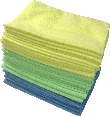Green cleaning can be really useful in keeping your environment safe and clean. Green cleaners can be non-toxic, biodegradable, and/or made from renewable resources, which is considered to be much better for the environment than a cleaner that is petroleum-based. You can either make them yourself (see green cleaning products) or get them pre-made from a website, brick-and-mortar store, or catalog.
One commonly cited statistic is that 17,000 petrochemicals are around for you to use in your home and only 30 of them have been tested for human and environmental safety. This concerns many people, particularly mothers of small children, as well as the elderly.
Some green products ingredients to look for are disinfecting plant oils like eucalyptus, sage, and rosemary in place of triclosan, borax in place of bleach, coconut and other plant oils instead of petroleum-based oils, and grain alcohol instead of butyl cellosolve. Butyl cellosolve is also known as butyl glycol, Dowanol, Bane-Clene and ethylene glycol monobutyl ether (EGBE) and is not only considered a toxic air chemical in California, but is also indicated in studies to cause liver and kidney damage. Also avoid products with phosphates and phtalates. Traditional cleaners like dishwashing liquid and baby shampoos can contain these last two substances and they can effect the environment and humans alike. In fact, phosphates can get into waterways and ruin ecosystems by causing algae blooms that rob other things living in the water of oxygen. And in animal studies, phtalates have caused developmental and reproductive toxicity. There are also a few human studies that show health outcomes changed by phtalates. And this is just the beginning.
Notice that not all products are as green as they say they are, since they is not a lot of regulation on who can say vaguely positive things on their packaging. Words like "natural" do not necessarily mean that the product you are viewing was not made from, say, petroleum. And the government does not check on who uses words like "non-toxic," "environmentally friendly," and "eco-safe," so anyone can use them to describe their products. There are a lot of good cleaners out there that you can use on your home and from which you will not have poor health repercussions. You can make them yourself or buy them in the store. Just make sure that, if you decide to purchase your cleaner, you are not taken in by fancy words and shiny labels that claim to be safer than they are.
Author Bio
Cassandra Merkling
Differences Between Formal Dresses and Cocktail Dresses
Sometimes formal and cocktail dresses can look an awful lot like the same basic dress, but there are some differences if ...
Discover More
Cleaning Laminate Flooring
Laminate floors are a beautiful and inexpensive option that more and more home owners are starting to use. Laminate ...
Discover More
Household Cleaners
There are a lot of household cleaners out there. This article focuses on the most common ones.
Discover More
The Power of Microfiber! Zwipes Microfiber Cleaning Cloths will become your favorite tool for every cleaning task. This 36-cloth package is perfect for hundreds of uses in the garage, kitchen, bathroom, laundry, and all around the house. Each cloth is tough, streak-free, lint-free, reusable, and washable. Check out Microfiber Cleaning Cloths today!
The Top Five Household Cleaners
Instead of trying to buy a different specialized cleaner for each surface in your house, you can make many of your own ...
Discover More
Shower Cleaners
You use your shower everyday, sometimes every other day, sometimes multiple times a day, either way that means your ...
Discover More
Homemade Dishwashing Detergent
Wanting to extend your cleaning dollar and still stay green? With very little investment you can actually make your own ...
Discover More
Subscribe
FREE SERVICE: Get tips like this every week in Cleaning Tips from Tips.Net. Enter your address and click "Subscribe."
View most recent newsletter.

Comments